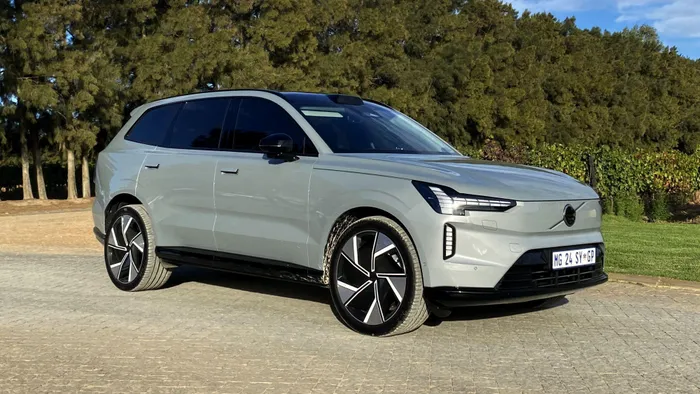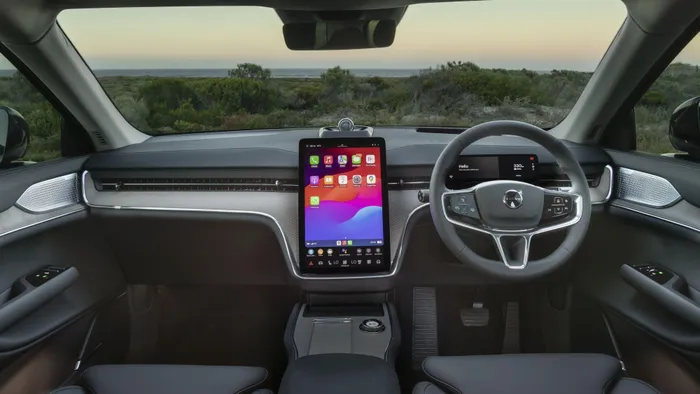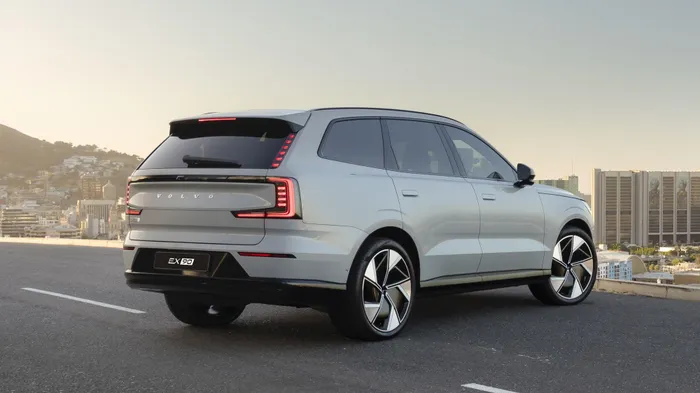REVIEW: New Volvo EX90 packs impressive tech, but takes minimalism a bit too far

The Volvo EX90 is imposing and technologically impressive.
Image: Jason Woosey
Volvo is of course synonymous with advanced safety features, and the new EX90 takes all that to the next level - it's nothing short of a super-computer on wheels.
That distinctive lump on its roof houses a Lidar system that can spot small objects hundreds of metres ahead. It pairs with eight cameras, five radars and 16 ultrasonic sensors to provide all the eyes and years you might require to keep you safe if your own senses are out of order.
Although superseding the XC90 as the Swedish brand’s new flagship SUV, the all-electric EX90 doesn’t directly replace its internal combustion sibling, which soldiers on in facelifted form.
The EX90 is really expensive, though. It’s only available in flagship ‘Twin Motor’ guise, with all the trimmings, but an eye-watering price tag of R2.65 million. Yet if you can stomach that, it is a relatively unique proposition for those seeking a large family-sized seven-seat electric vehicle.
Design and packaging
The EX90 follows a familiar design path, appearing like a logical evolution of the XC90, with smoother lines and a grill-less front end. It manages to be easy on the eye, yet still somewhat imposing on the road, which is a win in our book.
A shade over five metres long and almost two metres wide, the EX90 certainly is big and imposing, and as a result, it’s impressively spacious inside.
The big Volvo seats seven occupants in reasonable comfort. The third row seats can accommodate adults and teens at a push, but might not be ideal for longer trips. Impressively, the boot still swallows 324 litres of luggage with all seven seats in place, swelling to 697 litres if the third row is folded.
Interior and functionality
With Nvidia computing power and a Google operating system, the EX90 is a highly digitised vehicle.
A small digital cluster and head-up display system provide information in the driver’s line of sight, but most of the vehicle’s functions are operated via the large 14.5-inch vertical touchscreen, to the point of being annoying.

The cabin is packed with features and tech. Picture: Supplied
Image: Supplied
As with its smaller EX30 sibling, even the glovebox is opened via a button on the screen, and often you’ll need to swipe between various screens just to access basic functions.
The climate system thankfully has a permanent shortcut, but you still have to use the screen to control every single function, from temperature to fan speed, which is cumbersome compared to conventional physical controls.
I can’t help but feel they’ve taken the minimalism thing a bit far here. For instance, the driver doesn’t have separate electric window controls for the back windows. To operate these from the front, you must first use a toggle switch that transfers those ‘powers’ to the front window switches. In a R2.6m vehicle, I’d really like to think this is more about being eco-friendly than saving cost!
On that note, around 15% of the plastics used in the EX90 are recycled, and the seats, which are really comfortable, and offer a massage function, are upholstered in synthetic leather, which really feels like the real thing in this instance.
Despite the ergonomic niggles, the specification is still rather lavish, with standard features such as a fantastic Bowers and Wilkins audio system, a large panoramic sunroof and electric seating for the first two rows.
Overall the interior materials impart a feeling of quality that would befit a luxury car, but I wouldn’t go as far as calling the cabin super-premium. It’s not quite in the same league as a Range Rover, and you don't quite get that sense of occasion like you do in a modern Mercedes.
What it’s like to drive
With powerful electric motors on each axle producing a combined 380kW and 910Nm, the EX90 has a briskness that belies its 2.7-tonne kerb weight, and it is surprising agile through corners too.

Styling is modern and the lines are elegant. Picture: Supplied
Image: Supplied
Power delivery is incredibly smooth, and according to claims, the Twin Motor vehicle will sprint from 0-100km/h in 4.9 seconds.
Its road manners are generally impressive, but the ride quality did feel a little too crashy for my liking over harsher surfaces and ruts in the road, which I found somewhat disappointing given that the vehicle is equipped with air suspension as standard.
Thanks to a large 111 kWh lithium-ion battery pack, the EX90 achieves an impressive range. Volvo claims it will cover up to 751km in urban driving and 604km on the combined WLTP cycle, under ideal laboratory conditions.
Europe’s EV Database estimates a real-world range of 410km for highway driving and 650km for urban driving, in mild weather.
With about 80% range displayed on the onboard readout, I managed to do a trip from Roodepoort to Hartbeespoort - including a lengthy trip around the dam’s perimeter - without feeling any range anxiety and with plenty of battery juice to spare.
VERDICT
The Volvo EX90 is an impressive vehicle in many respects, packed with innovative safety technology and offering a compelling blend of performance, efficiency, luxury and practicality.
But on the downside, there are a number of small details that don’t quite match up to the vehicle’s steep price tag of R2.6 million. And with Volvo Cars SA closing more than half of its dealerships, the company now only offers coverage in the major centres of Gauteng, Durban and Cape Town, which could be of concern for customers who want to test out its impressive range capabilities with a Sho’t Left or two.
Related Topics: